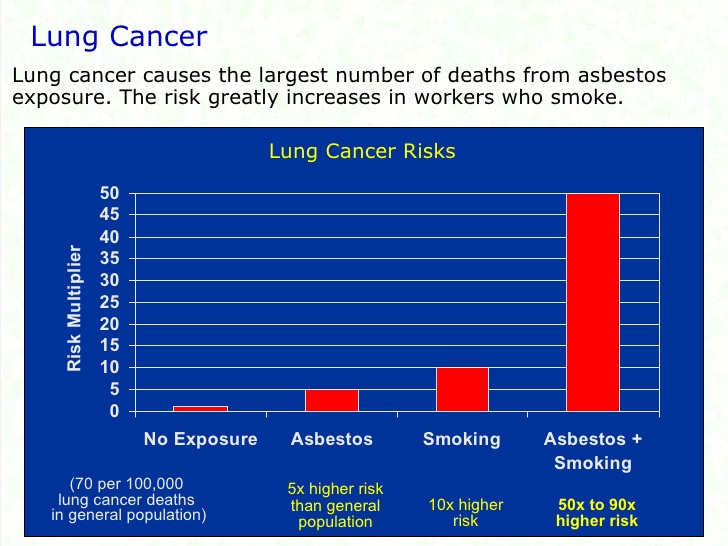Mesothelioma isn’t the only deadly cancer linked to asbestos exposure. This dangerous mineral can also cause lung cancer. While mesothelioma is caused by asbestos fibers becoming lodged in the pleural lining of the lungs, asbestos-related lung cancer can develop when those fibers are inhaled and lodged in the actual lung tissue. Mesothelioma is not considered a lung cancer.
Inhalation of asbestos is the most deadly and common form of exposure. Prolonged inhalation, which occurred most often at job sites where asbestos was used, especially increases one’s likelihood of developing some form of asbestos-related disease.
However, because lung cancer has other causes – most notably, smoking and pollution – it is much more difficult to identify asbestos as its primary cause. In addition, smoking can exacerbate this form of cancer.
Recent trends show that diagnoses of asbestos-related lung cancer are on the rise in those states which formerly relied on asbestos-heavy industries, particularly New York. At least partially due to the state’s history of asbestos-related jobs and lax safety regulations, about 13,500 of lung cancer cases are diagnosed annually. The prevalence of foundries, shipyards, and other blue collar jobs has led to high rates of asbestos-related cancers in the state.
Causes of Asbestos-Related Lung Cancer
In 1942, the National Cancer Institute confirmed that asbestos caused lung cancer.
Occupational exposure to asbestos was rampant throughout the better part of the 20th century. There were no workplace exposure limits set until the 1970s, and many industry workers were exposed to the cancerous substance before and after those regulations – many of them for years on end. Those at greatest risk for exposure included miners, shipyard workers, Navy veterans, textile workers, electricians, railroad workers, mechanics, and construction workers, just to name a few.
Of course, the concentration of asbestos fibers to which one is exposed and the duration of that exposure play a huge part in determining whether a person will develop lung cancer later in life. OSHA found a clear association between concentration levels of asbestos and the risk of lung cancer. Research also suggests that those risks of lung cancer increase up to 4% for every year a person is exposed. In general, the more asbestos you’re exposed to, the more likely you’ll develop lung cancer.
Some experts suggest that any asbestos exposure is enough to warrant a person receiving regular CT scans to check for lung cancer, whether or not that person is a smoker. While smokers can reduce their risk for lung cancer by quitting, they cannot reverse the effects of previous asbestos exposure.
How Asbestos Can Cause Lung Cancer
With over 220,000 cases diagnosed each year, lung cancer is a relatively common condition among Americans and the deadliest form of cancer in the U.S. for both men and women. However, most scientists estimate that around 90% of those cases are linked to smoking.
Asbestos-related lung cancer is a much more rare occurrence, with only about 4% of those diagnosed cases resulting from asbestos exposure.
So how does it develop? Typically, asbestos-related lung cancer is the result of severe and/or repeated asbestos exposure. Through inhalation, asbestos fibers become trapped in the lung tissue, which leads to inflammation, scarring and genetic damage, and eventually, the development of cancerous tumors.
Asbestos-related diseases develop over long spans of time. In terms of latency, this type of lung cancer is similar to mesothelioma, typically developing over the course of 15 to 35 years or more. That latency period can increase or decrease depending on levels of asbestos exposure and whether the victim is a smoker.
Though lung cancer always begins in the lungs, it can then spread to other areas of the body, making it much more difficult to treat.
Smoking and Asbestos-Related Lung Cancer Diagnosis
Because the overwhelming majority of lung cancer diagnoses are linked to smoking and many workers who were exposed to asbestos also smoked, determining the cause of an exposed smoker’s lung cancer can prove difficult. Unlike mesothelioma – the main source of which is asbestos exposure – lung cancer could have multiple potential sources.
Because of this, there are now set standards for diagnosing asbestos-related lung cancer.
Generally, for a doctor to decide that a person’s lung cancer is in fact asbestos-related, it must develop at least 10 years after exposure to the deadly mineral. Cases of lung cancer usually arise at least 15 years after exposure for most asbestos workers.
The risk for developing lung cancer is even greater in asbestos workers who smoke. (This is not true for mesothelioma.) It’s the combination of the two that is particularly dangerous. The theory is that smoking impairs the cilia of the lungs – the tiny parts responsible for cleaning out mucus and debris – making it difficult to dispel the asbestos. As more and more asbestos fibers accumulate in the lungs, the risk of lung cancer grows.
Smokers exposed to asbestos have a greater risk of developing lung cancer than if the risks of smoking and asbestos exposure were added together on their own.
The combination of these two factors is called a “multiplicative effect,” and for this reason, workers who successfully quit smoking can reduce their risk of lung cancer. However, for smokers who are also exposed to asbestos, their risks of developing lung cancer increase 50 to 84 fold.
The Helsinki Criteria
One further caveat in the diagnosis of asbestos-related lung cancer was established in 1997. Any doctor who claims that a patient’s lung cancer arose from asbestos exposure must show that it meets the Helsinki Criteria.
First, the victim must show that his or her lung cancer developed at least 10 years after he or she was first exposed to asbestos. Second, the victim must also show one of the following: 1) a diagnosis of asbestosis, 2) a high level of asbestos fibers in the lungs, or 3) a high level of exposure. These last two can be determined by air tests, witnesses, or lung sample counts.

